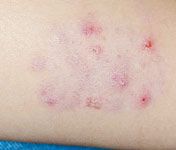Itchy, red rash plagues teenager
A frustrated teenage girl comes to your office complaining of an itchy, red rash on her right calf that she's had for 3 months.
THE CASE
A frustrated teenaged girl comes to your office complaining of an itchy, red rash on her right calf that she's had for 3 months. She has avoided sports because she is afraid to let the girls at school see her leg, which improves every time she applies a topical corticosteroid cream, but the rash recurs as soon as she stops.
DIAGNOSIS: Majocchi granuloma (dermatophyte granulomatous tinea corporis)

Other predisposing factors include chronic skin occlusion and systemic immunosupression.1 Lesions may appear in any hair-bearing area including scalp, face, forearms, hands, or legs. Skin lesions usually manifest as grouped or isolated papules or nodules near the border of a plaque. Lesions may become suppurative if superinfection occurs.
Two types of Majocchi granuloma exist: follicular and subcutaneous nodular.1 The follicular type usually presents as papules, pustules, and nodules in a follicular distribution within erythematous, scaling plaques. Distended hair follicles may also be observed.2
The subcutaneous nodular type typically occurs in chronically immunosupressed patients.1 Lesions commonly manifest as subcutaneous nodules and plaques, with or without pustules.2
DIFFERENTIAL DIAGNOSIS
Majocchi granuloma may closely resemble bacterial folliculitis, acne keloidalis nuchae, herpes simplex infection including herpetic folliculitis, furunculosis, pseudofolliculitis barbae, Kaposi sarcoma, kerion, lymphocytoma cutis, and nodular scabies.2
The typical appearance of lesions combined with a history of topical steroid use, skin occlusion, or frequent shaving should raise the clinical suspicion for Majocchi granuloma. If a topical antifungal has been used recently, KOH examination and culture may be negative. In such cases, a biopsy may be needed for definitive diagnosis.3
ETIOLOGY
The most common organism cultured from Majocchi granuloma is Trichophyton rubrum or, less common, T mentagrophytes or Epidermophyton floccosum.2 However, other dermatophytes have been reported to cause Majocchi granuloma.4
It is believed that the condition starts after physical trauma, and occlusion of hair follicles alters the structure. This serves as a portal of entry for the organism, together with keratin and other necrotic material, into the dermis.5 The dermatophyte invades the hair follicle and dermis, resulting in deep follicular papules and pustules and a foreign body granulomatous reaction.
Having "the talk" with teen patients
June 17th 2022A visit with a pediatric clinician is an ideal time to ensure that a teenager knows the correct information, has the opportunity to make certain contraceptive choices, and instill the knowledge that the pediatric office is a safe place to come for help.
Meet the Board: Vivian P. Hernandez-Trujillo, MD, FAAP, FAAAAI, FACAAI
May 20th 2022Contemporary Pediatrics sat down with one of our newest editorial advisory board members: Vivian P. Hernandez-Trujillo, MD, FAAP, FAAAAI, FACAAI to discuss what led to her career in medicine and what she thinks the future holds for pediatrics.